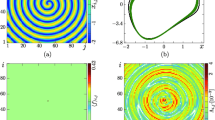Abstract.
By using a hard-wired oscillator network, multiple pattern generation of the lobster pyloric network is simulated. The network model is constructed using a relaxation oscillator representing an oscillatory or quiescent (i.e. steady-state) neuron. Modulatory inputs to the network are hypothesized to cause changes in the dynamical properties of each pyloric neuron: the oscillatory frequency, the postinhibitory rebound property, and the resting membrane potential. Changes in each of these properties are induced by changing appropriate parameters of the oscillator. By changing seven parameters of the network as a whole, modulatory input-dependent patterns are successfully simulated.
Similar content being viewed by others
Author information
Authors and Affiliations
Additional information
Received: 13 July 1999 / Accepted in revised form: 17 December 1999
Rights and permissions
About this article
Cite this article
Makino, Y., Akiyama, M. & Yano, M. Emergent mechanisms in multiple pattern generation of the lobster pyloric network. Biol Cybern 82, 443–454 (2000). https://doi.org/10.1007/s004220050597
Issue Date:
DOI: https://doi.org/10.1007/s004220050597




